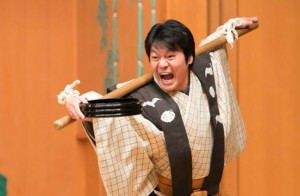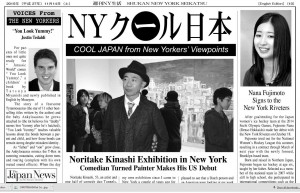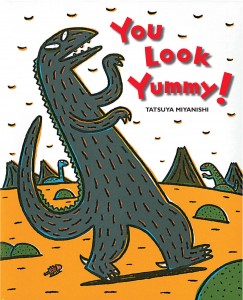JQ Magazine: Book Review — ‘You Are My Best Friend’
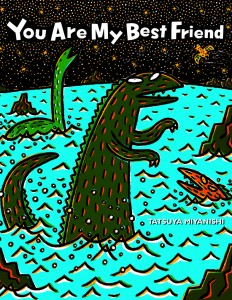
“Parents will enjoy the dinosaur’s uncanny resemblance to Godzilla and may even learn a thing or two about prehistoric creatures. Don’t worry, your kids won’t have a clue if you don’t pronounce them correctly—they’ll be too enthralled with the captivating story and dramatic images.” (Museyon)
By Heather Wilson Tomoyasu (Ibaraki-ken, 2004-06) for JQ magazine. Heather is a vlogger and blogger on her site US Japan Fam, author of “Legit Ways to Make Money from Home” (available on Kindle and iTunes), social media consultant, and mommy to twins plus one! You can follow and connect with her on Twitter, Instagram, Facebook, and Pinterest.
After a popular debut in his first children’s book, You Look Yummy, our tough but lovable friend Tyrannosaurus is back and better than ever thanks to author Tatsuya Miyanishi and his English publisher, Museyon (who also brought you 2014’s Kuma-Kuma Chan, the Little Bear). The second of a 13-book series, You Are My Best Friend features a similar transformation of the dinosaur from a violent and selfish creature to a kind and caring one, this time through the act of making a friend.
Through 26 vivid and brightly colored illustrations over 40 pages, you’ll follow Tyrannosaurus as he taunts smaller dinosaurs, finds himself ironically near death, and is then saved by another dino. This act of unexpected kindness brings about a change of heart in our tyrant, who suddenly finds himself with a best friend whom he must (spoiler alert!) in turn save at the end. The book is a heart-warming moral story that also serves up exciting twists and turns.
Parents will enjoy the dinosaur’s uncanny resemblance to Godzilla and may even learn a thing or two about prehistoric creatures. Elasmosaurus, anyone? How about Styracosaurus? No? Me, neither. Don’t worry, your kids won’t have a clue if you don’t pronounce them correctly—they’ll be too enthralled with the captivating story and dramatic images.
JQ Magazine: Book Review — ‘Japaneseness: A Guide to Values and Virtues’

“Japaneseness serves as the perfect introduction (or reintroduction) to many aspects of Japanese society you might find refreshing, fascinating or befuddling. Or at the very least, quintessentially Japanese. ” (Stone Bridge Press)
By Rashaad Jorden (Yamagata-ken, 2008-10) for JQ magazine. A former head of the JETAA Philadelphia Sub-Chapter, Rashaad is a graduate of Leeds Beckett University with a master’s degree in responsible tourism management. For more on his life abroad and enthusiasm for taiko drumming, visit his blog at www.gettingpounded.wordpress.com.
During my time in Yamagata Prefecture, I remember learning about filial piety, a virtue that the Japanese have historically cherished. I had heard about countless other values, principles and virtues that have been important in the daily lives of Japanese people. But I had totally forgotten them until…
Picking up a copy of Japaneseness: A Guide to Values and Virtues. Written by Yoji Yamakuse, Japaneseness serves as the perfect introduction (or reintroduction) to many aspects of Japanese society you might find refreshing, fascinating or befuddling. Or at the very least, quintessentially Japanese.
Yamakuse appropriately starts off the book by introducing readers to the value Japanese tend to treasure the most: harmony. Certainly, those familiar with the country recognize the importance of harmony in ensuring that a Japanese environment operates smoothly, and Yamakuse spends the first chapter explaining how related concepts (such as hospitality, thoughtfulness and modesty) contribute to maintaining harmony. That chapter—as well as the following eight (some of which are devoted to values like trust, virtue and reverence for the gods)—are further divided into sections that address other values and beliefs that are important in Japan.
Justin’s Japan: Nippon in New York — Nippon in New York: Musicals, origami, the GazettE, Keiko Matsui, Sakura Matsuri
By JQ magazine editor Justin Tedaldi (CIR Kobe-shi, 2001-02) for Examiner.com. Visit his Japanese culture page here for related stories.
Spring has sprung in the Big Apple, and that means one thing: a new season of sounds, colors, and spectacular performing arts to match the blossoming sakura trees throughout the city.
This month’s highlights include:
Friday, April 1, 7:00 p.m.
Leonard Nimoy Thalia at Symphony Space, 2537 Broadway
$30 advance, $25 seniors, $35 day of show
Shunzo Ohno, one of the most versatile and influential trumpeters in modern jazz, returns with ReNew, his 16th album as a leader. ReNew injects elements of traditional jazz, hip-hop, spoken word, and free jazz, creating a tapestry of modern jazz that is distinctly his own. With “recovery to discovery” in mind, the genre-defying album is a testament to those affected by catastrophic events that have taken place throughout the world including the 2011 tsunami in Japan. The concert performance will begin with the documentary film Never Defeated: The Shunzo Ohno Story, which is based on Ohno’s powerful life experiences. The music for the film centers on The International Songwriting Competition Grand Prize award song (featured on ReNew), “Musashi.”
April 4-28
Origami in Action: A New Approach to Applied Origami
RESOBOX, 41-26 27th Street (Long Island City)
Free, opening reception Friday, April 8, 7:00 p.m.
Origami is the art of paper folding, which is often associated with Japanese culture. In modern usage, the word “origami” is used as an inclusive term for all folding practices, regardless of their culture of origin. The goal is to transform a flat sheet square of paper into a finished sculpture through folding and sculpting techniques. Today, origami is truly a global phenomenon. Best known for making pop-up comic books, artist Sam Ita was asked by emerging Italian publisher Nui Nui to create a series of origami books, beginning with paper planes. Continuing the series, he collaborated with two other innovative origamists: jewelry and fashion designer Adrienne Sack, and dragon aficionado and champion pumpkin carver Paul Frasco. Their colorful works will be revealed in this special exhibition.
April 8-23
Japan Sings! The Japanese Musical Film
Japan Society, 333 East 47th Street
$12/$9 Japan Society members, seniors & students EXCEPT screening of You Can Succeed, Too + Opening Night Party: $15/$12 Japan Society members, seniors & students
This spring, Japan Society celebrates the astonishing yet little-known world of Japanese musical films. The series focuses on the golden age of the “popular song film” starring teen idols and TV stars from the ’50s and ’60s. It also reaches back to prewar singing samurai and forward to twenty-first century genre mashups—10 songful cinema gems all on 35mm! Musical performance in these films incorporates Japanese musical tradition as well as the utopian space of the Hollywood musical to create a rich commentary on the intimate and unequal relation between Japan and the U.S. This series is guest curated by Michael Raine, Assistant Professor of Film Studies at Western University, Canada.
For the complete story, click here.
JQ Magazine: Book Review — ‘The Japanese Lover’
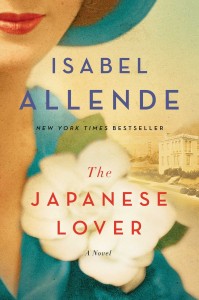
“The Japanese Lover has its ups and downs, but it does serve as an eventful tour of various aspects of 20th century history.” (Atria Books)
By Rashaad Jorden (Yamagata-ken, 2008-10) for JQ magazine. A former head of the JETAA Philadelphia Sub-Chapter, Rashaad is a graduate of Leeds Beckett University with a master’s degree in responsible tourism management. For more on his life abroad and enthusiasm for taiko drumming, visit his blog at www.gettingpounded.wordpress.com.
We might be keeping fascinating mementos from our daily lives that if discovered, might stun many people.
Certainly, letters documenting something shocking (well, shocking during a certain period of history) would classify as that. Isabel Allende’s The Japanese Lover highlights one woman’s relationship with a Japanese national during her eventful life.
The story’s protagonist is Alma Belasco, a native of Eastern Europe was sent to live with well-to-do relatives in San Francisco when she was young. During the latter years of Alma’s life, she lives with a caretaker named Irina Bazili, who learns about an important figure who shaped Alma’s life and is described in the title of the book: a man named Ichimei Fukuda. Ichimei could also be described as a secret lover because the two had to keep their romance on the down low as it occurred during the height of World War II when people of Japanese descent were considered a threat to American society. The Japanese Lover also takes a journey not only through Alma’s life, but Irina’s as well as Ichimei’s.
Presenters wanted for 2016 Japan Writers Conference
Posted by Tom Baker (Chiba, 1989-91), a writer and editor in Tokyo and a regular Japan Writers Conference participant.
The Japan Writers Conference is a free annual event for English-langauge writers in a variety of fields. It is held each autumn in a different part of Japan. The event attracts a fair number of JETs and JET alumni, and this year’s event, at Tokushima University on October 29-30, will be hosted by a former JET, the author and anthologist Suzanne Kamata (Tokushima, 1988-90).
The organizers are looking for writers, translators, editors, agents and publishers to give presentations at this year’s event. For those interested in presenting or simply attending, the remainder of this post contains practical information taken verbatim from an official announcment:
About the site, Suzanne writes, “Although off the beaten path, Tokushima University is reasonably accessible. It’s about an hour and a half by bus from Kobe (all buses on the way to Tokushima station make a stop in front of the university), and a short bus ride from the Awa Odori Airport. Tokushima, a city with a rich literary heritage, is settled on the banks of the Yoshino River. We’ve got nature and culture (both traditional, such as Japan’s largest Bon festival, Awa Odori, indigo dyeing, bunraku puppetry and pottery-making, and modern, as in J-pop, anime and manga).
“The conference will be held in Tokushima University’s brand new Glocal Building.”
She also says there are plenty of hotels nearby in the station area.
So mark your diaries, calendars, smartphones or whatever it is you use to keep track of things, and plan to join us. As the event shapes up, we will keep you posted.
This is also our first call for presentation proposals. All published writers, translators, editors, agents and publishers who would like to lead a session are invited to submit proposals. We especially encourage proposals from new submitters. One of the strengths of the Conference has been variety, and the best way to foster variety is to have new presenters each year.
Those who have presented at past conferences are (of course) welcome to submit new proposals. But please, in the words of Ezra Pound, “Make it new.”
Please forward this to any friend or colleague who might be interested. If you know someone the conference organizers might approach–either living in Japan or planning to visit Japan next autumn–send us your suggestion. If you have contact information, that would be a great help.
Detailed information follows, but briefly, a proposal needs to include a brief bio, including some publication credits, the type of presentation you wish to make, a title, a summary of 50 words, a longer abstract (150 words) and any special requests you might have. Standard sessions are fifty minutes long, but if you have something special in mind, please let us know and we will accommodate if possible.
Presentations on all genres and all aspects of writing and publishing are welcome. The deadline for presentation proposals is Wednesday, June 1, 2016.
As in the past, the Conference will be free and open to all who wish to attend. This is possible because all the presenters and organizing staff volunteer their time and talent, and the use of the site is donated by the host. As a result, the Conference cannot offer any payment, reimbursement, lodging, or help in securing visas or travel permits. So please don’t ask.
Proposal Guidelines
When planning your JWC proposal, keep your audience in mind. Your listeners will be writers and others (translators, editors, publishers, and agents) concerned with creating publishable writing. While teaching, literary studies and private self-expression are certainly worthy activities, they are not the focus of this Conference. Ask yourself as a writer or other word professional these questions:
What information do I have which could be useful to others?
What writing, rewriting, editing, or marketing techniques have worked for me or others I know?
What topic would make for a lively and enlightening discussion?
What publishing or other professional opportunities do I know about?
What will an attendee take away from my fifty-minute session that he or she will find worthwhile?
You may submit more than one proposal.
The only qualification one needs to be a presenter is to have published. This does not mean that you need to have published a lot or in some high-profile journal. Your book (if you have a book) does not have to be on a best seller list. You do not have to have won any awards or to have appeared on TV. You simply need to have written, edited, translated, or otherwise worked on a piece of writing which has made it to the public eye. That is, published.
Proposal Deadline and Format
Using the following format, please send your ideas for a presentation by June 1, 2015. Send your proposal in the body of an email (no attachments) to both these addresses:
gribblej@gol.com
bernmulvey_1@yahoo.co.jp
In your subject line give your name, “JWC,” and the date.
In the body of the email, give:
1. Your name (or names)
2. Contact information (email, telephone. These remain confidential.)
3. Your publications (Need not be complete, but give names of journals and genre for short pieces; title, publisher and date for books; venues and dates for plays, and so on)
4. Title of presentation. (20 words or less)
5. Type of presentation (short lecture with Q&A, craft workshop, panel discussion, reading with Q&A, etc.)
6. Short summary of the presentation (50 words or less)
7. Abstract of the presentation (150 words or less)
8. Personal and professional biography (50 words or less. Make mention of your publications, as this will be part of the Conference program)
9. Anything else, such as special equipment needs or questions.
Your proposal doesn’t have to be a “finished” document to submit. There will be time to shape and polish your ideas for a presentation. But there is a set number of session slots available and if you are interested in having one of them, please let us know soon. Again, the deadline is June 1, 2016.
John Gribble
Bern Mulvey
Co Co-ordinators,
2016 Japan Writers Conference
JQ Magazine: Book Review — ‘Up from the Sea’
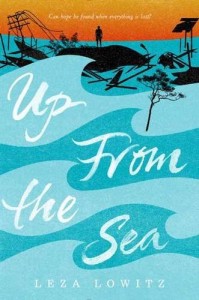
“If you’re interested in new perspectives of March 11, Up from the Sea is an easy read that might open eyes to the perseverance and strength of Tohoku’s residents.” (Crown Books for Young Readers)
By Rashaad Jorden (Yamagata-ken, 2008-10) for JQ magazine. A former head of the JETAA Philadelphia Sub-Chapter, Rashaad is a graduate of Leeds Beckett University with a master’s degree in responsible tourism management. For more on his life abroad and enthusiasm for taiko drumming, visit his blog at www.gettingpounded.wordpress.com.
The afternoon of March 11, 2011 brought unprecedented destruction along the Tohoku coast and challenges that many locals have struggled to overcome even up to this day. The survivors’ stories have been told many times since then. Now, young readers get another glimpse into that day and life in the disaster-stricken area.
Inspired by a young boy she met in the disaster zone, Leza Lowitz pieces together the events of that fateful Friday to create Up from the Sea, a fictional story (although based on the events of March 11 and its aftermath) about Kai, a teenager who uses soccer to rally his community. Up from the Sea also includes a trip Kai and others made to New York to commemorate the tenth anniversary of September 11.
Lowitz writes Up from the Sea as a verse novel instead of in prose, which makes the story a much quicker and easier read. It’s divided into three major chapters—each titled after a season of the year—that document the journey from the havoc caused by Mother Nature to an enormously successful soccer game organized in the disaster-stricken community. Kai is the narrator of the story and early on, you get the feel he is setting the stage for a documentary as he provides a brief introduction to his life and the morning of March 11— until 2:46 p.m., when Japan changes forever.
JQ Magazine: Book Review — ‘The Inland Sea’

“Richie’s acerbic humor and wit are coupled with lush scenery and descriptions, offering an intoxicating and wry getaway.” (Stone Bridge Press)
By Alexis Agliano Sanborn (Shimane-ken, 2009-11) for JQ magazine. Alexis is a graduate of Harvard University’s Regional Studies-East Asia (RSEA) program, and currently works as a program coordinator at the U.S.-Asia Law Institute of NYU School of Law.
The Inland Sea by the late Donald Richie is a legendary book in the Japan field. For many, it’s their first foray into the culture. Following Richie as he sets sail across the Seto Naikai, the body of water which spans between the islands of Shikoku, Honshu and Kyushu, The Inland Sea chronicles Richie’s quest for authenticity and escape. There, among the hamlets and fishing villages which dot the coastline, he paints for the readers a sun-drenched and hazy seascape; encapsulating his journeys into a memoir, history, and travel book all at once.
Originally written in the early sixties, published in 1971 and subsequently reprinted over the years, the newest edition by Stone Bridge Press deserves a place of honor on your bookshelf—and in your mind. Richie’s acerbic humor and wit are coupled with lush scenery and descriptions, offering an intoxicating and wry getaway. The book is a solid combination of sardonic and sublime. Written as a series of essays, it’s easy to thumb through the pages, find a spot at random, and pick up at a new leg of the journey with Richie—just as he catches a boat with the tide.
This edition also features photographs by Yoichi Midorikawa, the Japanese photographer renowned for his black and white photographs which highlight the scenic, if not austere, beauty of Japan. These images complement the narrative, helping to conjure up a sense of lonely nostalgia. Despite the wonder of the world Richie paints for us, it is one where undercurrents follow mercurial moods as the author mulls on life, Japanese society, and the ever-worshiped god of “progress.” The first sentence to the book sets the tone: “Kobe, from where I have just come, is indication enough of Japan’s sad future.”
Justin’s Japan: ‘You Look Yummy!’
By JQ magazine editor Justin Tedaldi (CIR Kobe-shi, 2001-02) for Shukan NY Seikatsu. Visit his Examiner.com Japanese culture page here for related stories.
For parents of little ones not quite ready for Jurassic World comes You Look Yummy!, a children’s book by Tatsuya Miyanishi and newly published in English by Museyon.
The story of a fearsome Tyrannosaurus (the star of 11 other bestselling titles written by the author) and the baby Ankylosaurus he grows attached to (the tot believes his “daddy” names him “Yummy” after he’s hatched), You Look Yummy!, teaches valuable lessons about the bonds between a parent and child, and how those bonds can remain strong despite mistaken identity.
As “father” and “son” grow close, the Ankylosaurus mimics the T-Rex in ramming mountains, cutting down trees and roaring (complete with his own muted sound effects). When the day comes for them to part, readers will be touched by what unfolds.
Children will be instantly attracted to Miyanishi’s illustrations. Throughout its pages, there are artistic touches like a white sky, coloring outside the edges to make the images pop, and hash marks for the dinos that serve as texture 101. Especially effective are scenes of a night sky jam-packed with stars and dotted with some exaggeratedly large ones (think Christmas tree). The result is something that feels like it could have been drawn by a child, but is secretly the work of a seasoned artist—after all, the Tyrannosaurus is a dead ringer for Godzilla.
For more information, visit www.museyon.com.
JQ Magazine: Manga Review — ‘Showa 1953-1989: A History of Japan’

“Shigeru Mizuki has led a full life of hardship and wonder. At the time of this book’s publication, he is 93 and still bringing laughter to many through his enormous body of award-winning work, which is thankfully becoming more available in English.” (Drawn and Quarterly)
By Julio Perez Jr. (Kyoto-shi, 2011-13) for JQ magazine. A bibliophile, writer, translator, and graduate from Columbia University, Julio currently keeps the lights on by working at JTB USA while writing freelance in New York. Follow his enthusiasm for Japan, literature, and comic books on his blog and Twitter @brittlejules.
Showa 1953-1989: A History of Japan is the fourth and final volume of the English translation of Shigeru Mizuki’s manga history of the Showa period. Translated for the first time into English by JET alum (and JQ interviewee) Zack Davisson (Nara-ken, 2001-04; Osaka-shi, 2004-06), the release of this book marks the end of a long journey for us readers. Mizuki took great pains to detail significant events of the Showa period and Japan’s role in World War II in order to preserve a comprehensive look at the time from the perspective of someone who had lived it. He intended this manga history to be a gift for all the generations born in a time of peace. As a reader born in the first year of the Heisei period, I was not even alive for any single event I read about, but nevertheless was moved by the power of Mizuki’s personal and historical storytelling and art to think about world history in new ways. The best part of reading something by Mizuki is you’re in for plenty of laughs along the way as well.
As a refresher for those of you who have been with us from the start, and an intro for those just tuning in, the first volume of this illustrated history of the Showa period in Japan covered the years 1926-1939 and highlighted a modernizing Japan and Mizuki as a child fascinated by spirits called yokai, and almost as importantly, a child obsessed with food. The book chronicled a number of incidents in Japan and Asia that took Japan down the road to World War II that come to a head in the second book which featured the years 1939-1944. This volume devotes itself to capturing the massive scale and harrowing death tolls of air-, sea-, and land-based conflicts in the war, and as time passes Mizuki’s own autobiographical narrative weaves in as he serves in the army. The third volume covers 1944-1953 and sees the darkest parts of Japanese history in World War II, and Mizuki’s own experiences are spotlighted, but it is not without the hope and admiration for humanity inspired from Mizuki’s encounter with the natives of Rabaul. This book also covers the Allied occupation of Japan and the beginning of what historians call “Postwar Japan” in which Mizuki starts down the path that will lead him to manga success and Japan becomes a booming economic power.
Interestingly, the last volume covers 1953-1989, which is 36 years of history and among the other volumes is the one that tackles the longest period of time. It’s also the most varied in its content. The same historical approach to events from a variety of perspectives narrated by either Nezumi Otoko or Mizuki himself persists through this volume, but as TV, movies, and popular culture take on an increasingly larger significance in society, so do strange events take on a more significant coloring in history. Mizuki devotes many pages to portraying abnormal events both comical and criminal that preoccupy the public mind by way of showing how times have changed since before the war. For this reason, the fourth volume at times can sometimes feel like a series of short historical episodes told in manga form, but of course presented in a chronological and unified way.
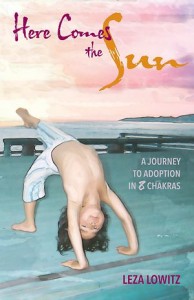
“Here Comes the Sun conveys how with persistence, perseverance and patience, seemingly impossible hurdles in Japan can be overcome.” (Stone Bridge Press)
By Rashaad Jorden (Yamagata-ken, 2008-10) for JQ magazine. A former head of the JETAA Philadelphia Sub-Chapter, Rashaad is a graduate of Leeds Beckett University with a master’s degree in responsible tourism management. For more on his life abroad and enthusiasm for taiko drumming, visit his blog at www.gettingpounded.wordpress.com.
“Sometimes, you have to travel a very great distance to find a home within yourself.”
That saying could certainly describe the journey of Leza Lowitz, a Californian who has worked extensively in Japan. She chronicles her path through several eventful periods—such as adolescence during the tumultuous early 1970s, her romance with a Japanese man named Shogo (whom she eventually weds), and her attempts to adopt in Japan in Here Comes the Sun: A Journey to Adoption in 8 Chakras, an autobiographical story that captures the ups and downs of Lowitz’s efforts to carve a niche in Japanese society.
As indicated by the subtitle of the book, Lowitz utilizes the influence of another culture to best integrate herself into Japanese society. But first, you might be asking… what’s a chakra? Derived from the Sanskrit root car (“to move”), a chakra represents a major wheel of energy in the human body, and each chakra contains a particular function. Chakras regulate, distribute and balance the energy and nerve functions of their locations.
Lowitz calls the chapters in Here Comes the Sun “chakras” and each one contains a certain theme. For example, the first chapter in the book is titled Muladhara, derived from the Sanskrit word for “root” or “support.” Some chapters in Here Comes the Sun deal directly with the yoga practices that balance a chakra—Lowitz tells us when the aforementioned primary chakra is balanced, you’ll feel stable and secure while being in a better position to succeed.
JQ Magazine: Book Review — ‘Kendo: Culture of the Sword’
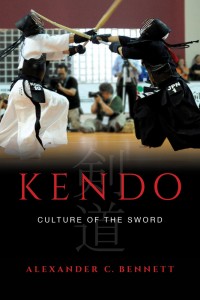
“Truly grasping Kendo might feel like learning Japanese—it’s a never-ending journey that feels overwhelming. But with persistence, the content will become easier to understand and quite enjoyable.” (University of California Press)
By Rashaad Jorden (Yamagata-ken, 2008-10) for JQ magazine. A former head of the JETAA Philadelphia Sub-Chapter, Rashaad is a graduate of Leeds Beckett University with a master’s degree in responsible tourism management. For more on his life abroad and enthusiasm for taiko drumming, visit his blog at www.gettingpounded.wordpress.com.
At pep rallies for my school’s sports clubs during my time on JET, I occasionally saw students decked in armor and masks while gripping swords. They were obviously members of the kendo club, but I had no idea what they actually did (other than participate in a martial art I knew nothing about). I was excited to start reading Kendo: Culture of the Sword so I could be properly introduced to the sport.
Written by Alexander C. Bennett, a New Zealander who has served as a professor at Kansai University and the coach of his country’s national kendo team, the book illustrates how kendo has evolved throughout the years from, among other things, a form of military training to a sport in which world championships are conducted every three years. More importantly, Kendo would teach me what happens in the sport.
Indeed, my initial expectations for the book were satisfied early when Bennett explained the “complex” rules and methods of kendo (even before mentioning the rules, he does us a gigantic favor by presenting the various names for Japanese swordmanship throughout the years—kenjutsu was actually the term long used to refer to the martial art). He also shines when he includes images of the sport’s equipment as well as a table detailing how you score a point. Bennett also provides fascinating information about the state of women in kendo: although there are references to women doing kendo that date back to early modern Japan, women only largely started practicing the sport after World War II (girls were traditionally taught naginata or kyūdō instead of kendo). In addition, even though women compete nationally and internationally in championship competitions, very few women hold positions of power in kendo education at a regional or national level.
JQ Magazine: Book Review — ‘Yurei: The Japanese Ghost’
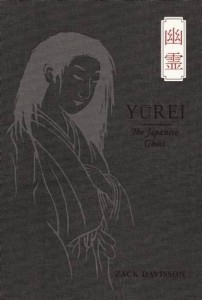
“If you like reading about mythology and supernatural horror around the world, or if you enjoy Japan’s unique brand of horror from such films as The Ring and The Grudge, then Yurei: The Japanese Ghost is a must-read.” (Chin Music Press)
By Julio Perez Jr. (Kyoto-shi, 2011-13) for JQ magazine. A bibliophile, writer, translator, and graduate from Columbia University, Julio is currently working at JTB’s New Jersey office while seeking opportunities with publications in New York. Follow his enthusiasm for Japan, literature, and board gaming on his blog and Twitter @brittlejules.
Do not read this review.
If you are foolish enough to read this review to the end…after seven days, you will be followed by a lingering spirit which will slowly, but unrelentingly, press more and more of its weight upon your shoulders. The weight will build to an unbearable breaking point, leaving you weak and overwhelmed by the scent of rotting flesh, driving your mind to unknowable depths of madness and despair. You can avoid this terrible fate by sharing this book review via the social media outlet of your choice or by purchasing Yurei: the Japanese Ghost, a new and excellent nonfiction effort by JET alum Zack Davisson (Nara-ken, 2001-04; Osaka-shi, 2004-06).
No doubt you’ve seen or heard of such films as The Ring and The Grudge, which have served as ambassadors of Japan’s very rich ghost culture (not to mention Halloween staples), but it is likely that there are aspects of these Japanese movies that you may have not been able to appreciate on some level. This book’s purpose is to fill in those gaps and fascinate you with an expertly catalogued evolution of ghost stories in Japan, and how pervasive they remain in pop culture to this day.
What exactly is a yūrei and why is it different from a Western ghost? What’s with the white face and long black hair? Why water? What drives the yūrei to do what it does? These questions and more are answered in this book. In the author’s words, “The goal of this book: to provide this understanding, to allow a clearer insight not only into the popular products of Japan but also the history and culture from which they sprang.” Yurei: The Japanese Ghost is a guided tour of the yūrei, from their appearance, to the rules they obey, to the traditions behind these characteristics. Davisson achieves this goal through the use of highly enjoyable primary choices and sharing the fruits of much academic research.
JQ Magazine: Book Review — ‘Mashi’
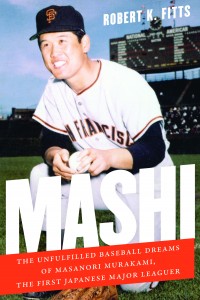
“JETs reading Mashi will relate to the story because just as many of us had support systems of friendly faces outside of the workplace, Murakami was fortunate that members of the Japanese American community in both Fresno and San Francisco provided a helping hand when he needed it.” (University of Nebraska Press)
By Rashaad Jorden (Yamagata-ken, 2008-10) for JQ magazine. A former head of the JETAA Philadelphia Sub-Chapter, Rashaad is a graduate of Leeds Beckett University with a master’s degree in responsible tourism management. For more on his life abroad and enthusiasm for taiko drumming, visit his blog at www.gettingpounded.wordpress.com.
During your JET experience, you probably heard about Japanese baseball icons such as Ichiro, Daisuke Matsuzaka, Hideki Matsui and Yu Darvish excelling in Major League Baseball. However, well before all of them were instilling pride in their countrymen through their feats on American diamonds, one southpaw from rural Yamanashi Prefecture was setting the big leagues on fire.
Baseball historian Robert K. Fitts introduces fans of the sport to Masanori Murakami in Mashi: The Unfulfilled Baseball Dreams of Masanori Murakami, the First Japanese Major Leaguer. The biography documents how Murakami went from a run-of-the mill relief pitcher for the Nankai Hawks to a major contributor to the San Francisco Giants in the mid-1960s that nearly punched a ticket to the World Series—all while being the subject of a fierce tug-of-war between the two organizations.
Piercing together information he obtained from interviews with Murakami, the pitcher’s close friends and experts on Japanese baseball, Kitts explores Murakami’s improbable journey to baseball stardom. Murakami was actually uninterested in baseball as a child and when he did develop a deep love for the sport, his father Kiyoshi objected to his son’s new passion. But Kiyoshi relented when he realized his son could earn a scholarship to an elite Tokyo-area high school.
Despite being a high school starter, a pro career was really not on the cards for Murakami, as his main focus was on attending college (and possibly pitching at that level). However, his success at Hosei II High School made him an attractive pro prospect and representatives from several NPB (Nippon Professional Baseball) teams offered him contracts. One of those teams was the Nankai Hawks, and they offered him something more than solely the opportunity to make a lot of money: the possibility of going to the United States to improve his craft, an idea that intrigued him.
JQ Magazine: Book Review — ‘Marathon Japan’

“The running boom in Japan shows no signs of slowing. Marathon Japan explains why as it marvelously highlights a growing and evolving sport.” (University of Hawai’i Press)
By Rashaad Jorden (Yamagata-ken, 2008-10) for JQ magazine. A former head of the JETAA Philadelphia Sub-Chapter, Rashaad graduated from Leeds Beckett University with a Master’s degree in Responsible Tourism Management (for more on his life in the U.K., visit his blog at www.gettingpounded.wordpress.com). While in Japan, Rashaad completed the 2010 Tokyo Marathon, ran two half marathons in Yamagata Prefecture, was a part of an ekiden club, and finished fourth in the 2009 Ishidan Marathon (a race up the steps of Mount Haguro).
Hopefully, your JET experience included you busting out your running shoes and joining your prefecture (or village) in a road race. It did for me on several occasions. But if you never got around to working up a sweat over 10 kilometers (or maybe even 21), you might remember your school being enthralled by its annual ekiden, or frequently seeing races televised on Sunday mornings.
So why have such events become an integral part of Japanese sporting culture? Thomas R.H. Havens examines why in Marathon Japan, the first comprehensive English-language book about the history of marathons and ekiden in the country.
Long before Kenya emerged as the world’s elite marathon nation, Japan could make a serious claim to producing the world’s best at 42.195 km. Marathon Japan illustrates the periods when Japanese marathoners dished out most of the world’s fastest times—such as the 1930s (In 1934, nine of the world’s ten fastest times were run by Japanese), the 1960s (1965 alone saw the Japanese record fifteen of the world’s top twenty marathon times), and the 1980s (during which Toshihiko Seko won ten of the fifteen marathons he completed in). And to top it off on the women’s side, in 2004, three Japanese finished among the world’s top eight marathoners.
JQ Magazine: Book Review — ‘Monkey Business Volume 5’

“Monkey Business is a magnetic force that attracts writers who can create magical kingdoms in a single page.” (A Public Space)
By Brett Rawson (Akita-ken, 2007-09) for JQ magazine. Brett is a writer, translator, and Ramen Runner. He has an MFA in Creative Writing Non-Fiction from The New School, and his writing has appeared in Narratively and Nowhere magazine. He is also co-founder of the quarterly publication The Seventh Wave and founder of Handwritten, a place in space for pen and paper.
After reading Monkey Business Volume 5, the image of a blender might pop into your mind. Perhaps this is because it is almost summer and you have recently begun making smoothies in the early morning. Or perhaps this is because you came across the description Monkey Business as genre-defying, which made you think of cross-genre, blending boundaries, and thereafter, the physical image of the object itself: the blender.
But most likely, this is because you read the opening vignette to Monkey Business, “Photographs Are Images,” by rising Japanese writer Aoko Matsuda, which ends as such:
Everything you’ve read up to this point has been images. […] These strings of letters are images. These chains of words are images. Stories are images. The story you’re reading this very minute is an image.
Carefully selected as the opener to Volume 5, this year’s Monkey Business is all about ways of seeing, and perceiving, images and the imagination, and objects and subjects.

